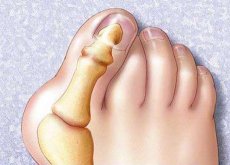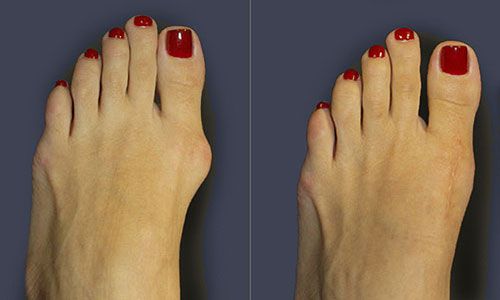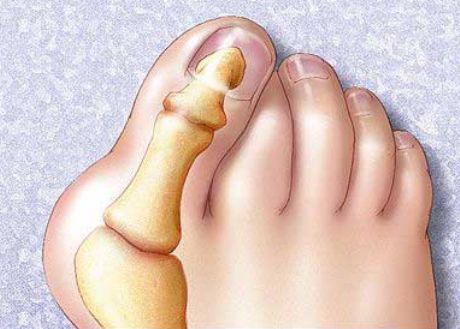Why are the bones on the legs formed?
Last reviewed: 17.10.2021

All iLive content is medically reviewed or fact checked to ensure as much factual accuracy as possible.
We have strict sourcing guidelines and only link to reputable media sites, academic research institutions and, whenever possible, medically peer reviewed studies. Note that the numbers in parentheses ([1], [2], etc.) are clickable links to these studies.
If you feel that any of our content is inaccurate, out-of-date, or otherwise questionable, please select it and press Ctrl + Enter.

Bones on the legs, bumps on the legs or valgus deformation of the thumb - all these are the names of one bad disease. In this disease, the joint of the big toe is deformed and it can not be returned to its original form, especially if the disease has spilled into a neglected form. Why are the bones on the legs formed and how can this be prevented?

Here is an inheritance: bones on the legs
Many surgeons believe (and not without reason) that the bones on the legs can be formed as a result of hereditary predisposition. If the closest relatives had a tendency to joint disease, in particular, arthritis, arthrosis, then children and nephews, even grandchildren, have a maximum risk of developing ossicles on their legs.
Especially at risk are those people with a hereditary predisposition to valgus deformity of the thumb, in the diet of which there is little calcium, which suffer from excessive weight and who wear uncomfortable shoes with narrow socks (especially women).
What to do?
Protect your feet, make up the right diet and be sure to consult a traumatologist at least once every six months, if you are worried about even a slight pain in the joints of the legs.
It should be remembered that the deformation of the ligaments located in the foot is in many cases hereditary, genetically conditioned. Therefore, you need to protect them and not overload, if your relatives had cases of cones on their feet.
Risk groups
Adolescents (hormonal restructuring in the body causes inflammation of the joints and the appearance of ossicles on the legs)
Pregnant women (hormonal adjustment and weight gain, which presses on the joints of the foot)
The period of breastfeeding (a hormonal storm in the body and a lack of many nutrients in the body of the mother, in particular, calcium, which is necessary for the development of joints and bone tissue)
The period after menopause (when many hormones are no longer secreted by the body, the joints and bones become brittle and fragile, become inflamed and hurt).
Women associated with the world of fashion and business, who most of the time are forced to spend on heels, as well as in tight and uncomfortable shoes
People of "standing" professions - sellers, teachers, hairdressers, etc. - they have an increased load on the feet, which causes them to develop bones. Note that a woman who has a normal foot without flat feet, which spends in the standing position up to 8 hours, after a few months can get such an unpleasant disease as flat feet.
How are flat feet and the appearance of bones on the legs?
Flat-footedness is a violation of the natural position of the foot. There are three stages - transverse, longitudinal and initial. With transverse flatfoot, the transverse arch of the foot drops. From this, the toes begin to diverge like a fan. And their natural position is to be located parallel to each other.
When this natural position is broken, the toes begin to interfere with each other, run into each other like carts. In this case, the big toe - the largest and the thickest - all its weight is pushed to the other fingers, rubs against them and inflames. Its shape becomes twisted, the head emerges from the joint (though not all, but in part), and on the finger it turns out such a small knob or bone.
This is the initial process, in which pain is still not strong.
Then the thumb moves on the other fingers even more. They, defending themselves against constant friction and pressure, begin to cave in. From this weak at first the pain becomes stronger, the person begins to suffer. Now the bone on his legs is no longer just a cosmetic defect, but a real medical problem. But by this time, the fingers are already used to being in the wrong position and getting them back in place is a big problem.
Symptoms of bones on the legs due to flat feet

First, an easy, then more severe pain, such that it is already very difficult to wear normal shoes. A bump on the finger interferes with its normal wearing. The joint becomes swollen, can acquire a reddish hue. Feel the aching joint becomes hard, like a corn.
Symptoms-bones precursors on legs
Before the bones on the legs can be clearly seen, even before their formation you can see symptoms-precursors. This fatigue of the legs, especially in the evening, - and stronger than usual, fatigue throughout the body, as well as strong swelling of the feet. All these symptoms are especially evident in the evening, after a busy day on their feet. To them can be added also reddening, and calluses on the big toe or on other part of a foot.
If you find these symptoms - ask for an examination to the orthopedist, so as not to miss the more insidious development of the disease. Such as a bone on his leg.
The reason for the appearance of bones on the legs is extra pounds
Excess weight is a risk factor for those people who have bones on their legs. By themselves, they certainly do not arise. They develop gradually, gradually, and the big weight of a body which puts pressure on feet, adding to it loading almost twice habitual is guilty in it.
Human foot - huge hard workers. They stand on themselves a mass, much larger than all other organs combined. From this, the feet become flatter, causing the fingers to deform. If a person at the same time is not eating properly, allowing himself fatty, salty, meat, flour dishes in an amount far from a reasonable rate, this negatively affects also the bone and the muscular system.
Increased weight is also an increased risk of injury when falling, stretching joints, ligaments and tendons, which is why the stop can not perform its usual, natural functions. Injuries and stretches provoke the wrong position of the toes, which can begin to develop a bone on the legs.
Risk groups
- People with obesity
- People who are prone to obesity
- Those who have a metabolic disorder
- People who have access to fatty, salty, fried foods (for example, cooks)
- People who have a metabolic disorder
- Those with a hereditary predisposition to excess weight
- Nursing mothers
- Pregnant women (stress on joints increases)
Other causes of bones on the legs
It can be concomitant diseases of the joints, feet, ligaments of the foot. Among these diseases, there is arthrosis, bursitis, exostosis, inflammation of metatarsophalangeal joints, osteoporosis.
The development of the bones on the legs is also promoted by shoes that are too tight or which are improperly cut (we are talking first of all about the shoe). Wearing high, above 4 cm, heels also provokes the appearance of valgus deformity of the big toe, as the foot assumes the wrong position and remains in this position for quite a long time.
Among the reasons for the development of ossicles on the legs are injuries of the legs, lower leg, feet, sprains and tendons. These injuries can be acquired at birth or already in adulthood.
Bones on the legs can develop and in those people who have suffered severe diseases of the nervous system associated with overstrain and inflammation of the muscles. These can include diseases such as cerebral palsy or polio.
Whatever the reasons for the appearance of ossicles on the legs, you need to consult an orthopedic doctor for consultation already at the initial stage of the disease in order to exclude more serious health consequences.

